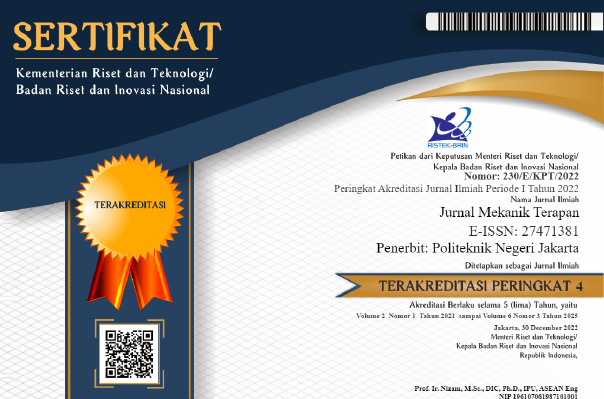Energy Analysis on Freezers Before and After Adding Receivers
DOI:
https://doi.org/10.32722/jmt.v4i2.5892Keywords:
Receiver, freezer, energy savingAbstract
Freezing machine is a tool that is widely used to maintain the quality of food ingredients. However, freezing technology requires more energy than other preservation technologies, therefore an energy-efficient freezer is required. The aim of this research is to study and determine the freezing process energy in a freezer using a receiver and without a receiver. This article reports a comparison of the energy used in a receiverless freezer and a receiver freezer, using R404A working fluid. Each to cool and freeze 1 kg of mass water for 180 minutes. The receiver is placed between the condenser and the filter dryer in the freezer system circuit. As a result, the freezer without a receiver has a COP of 2.55, and the highest use of electrical energy consumption is 1.90 [kWh] or the average electric power of the compressor drive is 634.4 [W]. While the use of electrical energy consumption in a freezer without a receiver is low at 1.01 kWh or the average electric power of the compressor drive is 335.7 [W]. Thus, the freezer using a receiver is 47% more efficient than a freezer without a receiver, the other result is that the water-ice temperature can reach -31oC lower than -14oC. This shows that the performance of the freezer with receiver is better than the freezer without receiver.
References
K. CHOPRA, V. SAHNI, and R. S. MISHRA, International Journal of Air-Conditioning and Refrigeration 22, (2014).
K. Megdouli, B. M. Tashtoush, Y. Ezzaalouni, E. Nahdi, A. Mhimid, and L. Kairouani, Appl Therm Eng 122, (2017).
A. H. Tambunan, T. E. Sihaloho, D. M. Kamal, and J. P. Sitompul, International Journal of Exergy 10, 321 (2012).
E. T. Berman, Torsi (2015).
S. Kashyap, J. Sarkar, and A. Kumar, International Journal of Refrigeration 135, (2022).
Y. Yang, G. Cui, and C. Lan, Renewable and Sustainable Energy Reviews 113, 109230 (2019).
P. Sukusno, R. P. A. Setiawan, Y. A. Purwanto, and A. H. Tambunan, Cogent Eng 6, (2019).
Y. A. Çengel and M. A. Boles, Thermodynamics: An Engineering Approach (McGraw-Hill, 2004).
M. M. Joybari, M. S. Hatamipour, A. Rahimi, and F. G. Modarres, Int. J. Refrig. 36, 1233 (2013).
G. Pottker and P. Hrnjak, Int. J. Refrig. (2015).
K. Chopra, V. Sahni, and R. S. Mishra, J. Therm. Eng. (2015).
Downloads
Published
How to Cite
Issue
Section
License
Copyright (c) 2023 Paulus Sukusno, Benhur Nainggolan, Dianta Mustofa Kamal

This work is licensed under a Creative Commons Attribution-ShareAlike 4.0 International License.
Jurnal ini berlisensi Atribut Berbagi Serupa 4.0 Internasional (CC BY-SA 4.0)
Anda diperbolehkan:
- Berbagi — menyalin dan menyebarluaskan kembali materi ini dalam bentuk atau format apapun;
- Adaptasi — menggubah, mengubah, dan membuat turunan dari materi ini untuk kepentingan apapun, termasuk kepentingan komersial.
Berdasarkan ketentuan berikut:
-
Atribusi — Anda harus mencantumkan nama yang sesuai, mencantumkan tautan terhadap lisensi, dan menyatakan bahwa telah ada perubahan yang dilakukan. Anda dapat melakukan hal ini dengan cara yang sesuai, namun tidak mengisyaratkan bahwa pemberi lisensi mendukung Anda atau penggunaan Anda.
-
BerbagiSerupa — Apabila Anda menggubah, mengubah, atau membuat turunan dari materi ini, Anda harus menyebarluaskan kontribusi Anda di bawah lisensi yang sama dengan materi asli.
- Tidak ada pembatasan tambahan — Anda tidak dapat menggunakan ketentuan hukum atau sarana kontrol teknologi yang secara hukum membatasi orang lain untuk melakukan hal-hal yang diizinkan lisensi ini.






